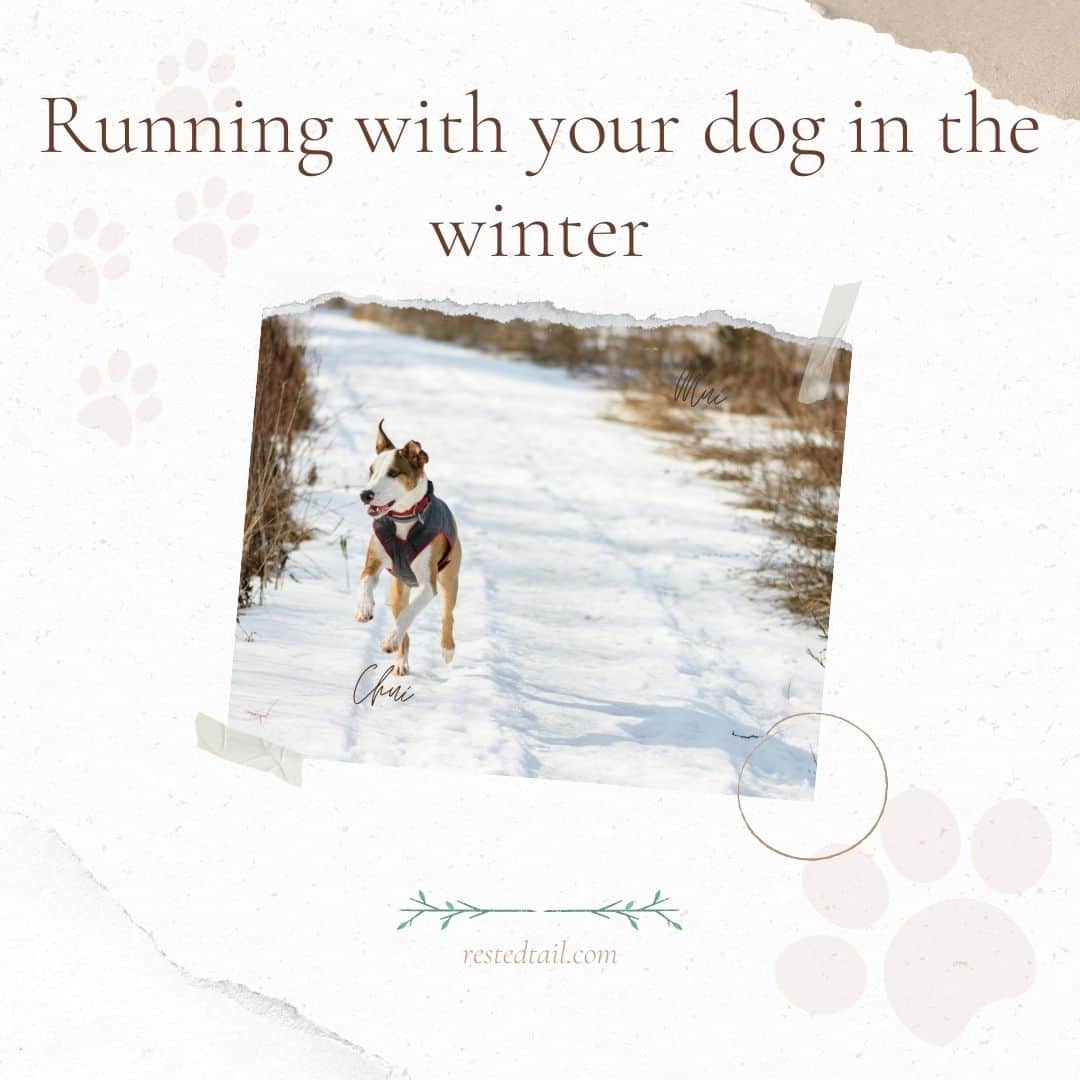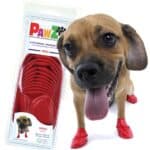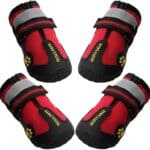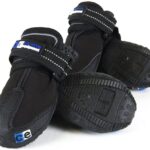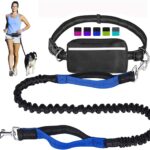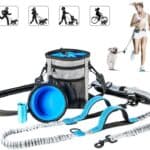Do you enjoy running with your pup? My neighbor Sophie certainly does. If you live in Canada like Sophie and me, you know the temperature typically drops below the freezing point during the winter. Only the most avid runners, like Sophie, head outside when the cold season comes around.
Before you decide to take your dog out for a winter run, you should understand the risks and use specific methods to keep you and your pup safe.
Note: This article is not a substitute for professional veterinary help. Please always consult with your local vet for any medical issues your pup might have.
Winter Running Safety
Hypothermia poses the most significant risk for injury to both you and your dog while running during the winter. Generally speaking, follow the basic rule that if the outdoor temperature feels too cold for you to run, then it probably is too cold for your dog.
Cold temperatures can cause exposure, windburns, frostbite, and hypothermia. Exposure and windburns cause discomfort, but frostbite and hypothermia can lead to long-lasting and potentially life-threatening conditions.
Symptoms of hypothermia in dogs and humans appear the same.
- Shivering – Your dog is shivering and trembling, which are signs of trouble with your dog, so monitor her closely.
- Lethargy – Your dog is exhausted, slow, groggy, listless, and uninterested in everyday activities.
- Stiff muscles – Your dog moves slowly or refuses to walk, cry, or whine when trying to move or change body movements or posture.
- Pale or gray gums – Your dog’s gums should look as healthy as yours: salmon pink and a little bit shiny.
- Stumbling or lack of coordination – Your dog staggers, stumbles or falls over while running or walking.
- Fixed and dilated pupils – Your dog’s eyes appear rounder or show much more white around the outside.
- Slow breathing rate – Your dog has flared nostrils, breaths with an open mouth but doesn’t pant, breathes noiselessly, or inhales with her head fully extended and held low.
Prepare to Run in Cold Weather
Surprisingly, not many pet owners realize they should protect their dogs from the cold weather.
Dog Coat
Most small dogs and larger dogs with short fur coats should wear a dog coat in frigid temperatures. Dogs like Corgis have thick fur, but their bellies sit low to the ground. For that reason, they should have a winter dog coat. Consider using a coat for senior dogs that suffer from arthritis or a weakened immune system since body heat regulation declines with age.
Good: SlowTon Winter Dog Coat
Key Features: Waterproof, windproof, and snowproof exterior to withstand winter attacks for your playful pup. Thick inner fleece lining brings ultra warmth. Elastic leg loops, flexible collar cord, and adjustable button closure give your canine the necessary space for movement. The harness hole on the back allows the leash to go through for convenient use. Reflective stripes and color help avoid an accident and loss by increasing visibility.
Better: Carhartt Chore Coat
Key Features: 12-Ounce, firm-hand, 100% ring spun cotton Duck dog vest with water-repellent coating quilted nylon lining for warmth and easy on and off corduroy-trimmed collar tucks into coat two rivet-reinforced pockets. It comes with a fully-adjustable hook-and-loop neck and chest tabs.
Best: Hurtta HU932648 Extreme Warmer Dog Coat
Key Features: The extreme warmer provides versatile protection and provides efficient warmth for extended outdoor activities in cold conditions and during training or competition. The extreme warmer will keep your dog warm in demanding conditions. It is also particularly well suited to outdoor activities in winter. The coat’s unique lining material reflects the dog’s heat. It stimulates its blood circulation efficiently, unlike a regular winter jacket, which helps the dog’s muscles stay warm and prevent injuries during activities. The lining fabric is a smooth polyester fabric that will not tangle the dog’s fur.
Dog Boots
You know your dog won’t say anything if she’s experiencing pain or discomfort on the run. Dog boots benefit your dog when its feet typically collect ice, snow, and salt between her toes. Ensure your dog’s shoes fit comfortably and don’t fall off.
Good: Pawz Disposable Dog Boots
Key Features: Pawz Dog Boots provides year-round protection from ice, snowmelt, salt, and street chemicals while in the summer from hot pavement, sand, and trails. They maintain their Health by keeping their paws from collecting allergens, chemicals, and mud that will prevent them from licking their paws and ingesting these dangerous elements.
Better: QUMY Dog Boots Waterproof Shoes 
These #1 bestsellers make running with your dog in the winter so much safer for your canine.
Key Features: This set of flexible dog boots will act as a good partner for them, protecting the paws against hurt from sidewalks, asphalt, grass, etc. The sole of the waterproof, durable dog shoes is sturdy, flexible, skid-resistant, and allows the dog boots to be used indoors or outdoors, in wet and dry, hot and cold conditions. These dog shoes are sturdy enough to withstand outside play and protect your dog’s paws from stones, dirt, and mud. Wide split seam top opening, making it very easy and quick to put on the dog boots.
Best: Canine Equipment Ultimate Trail Dog Boots 
Key Features: The boots protect from sharp rocks, branches, hot pavement, and more. These all-terrain boots combine a water-resistant, breathable softshell fabrication and recycled rubber soles that improve traction. The front and hind boots fit front and back paws differently, and the reinforced toe offers additional protection. The low-profile boots have a gusset for easy entry onto the foot, and the cinch closure allows for a secure fit.
Running Belt and Dog Leash
When used combined with a harness, a hands-free running belt and dog leash make running much more manageable in the winter. Rather than keeping your hand on a leash, you use the belt to direct your dog in the right direction. Before heading out on an arduous run, train your pup in small exercise sessions to familiarize her with it.
Good: Pet Dreamland Hands-Free Leash

Better: LANNEY Hands-Free Dog Leash for Running
Key Features: Perfect degree of flexibility, reduces stress from pulling and tugging, absorbs abrupt changes of direction of your dog. The leash length is 49″ when the bungee is relaxed and extends up to 69″. The nylon waist belt is 1.1″ wide. It adjusts from 27″ to 46″. Reflective stitching throughout the leash and waistband increase visibility in low light. It comes with a waist pouch designed to supply poop bags, keys, phones, cards, or other small items. The pouch is detachable and easy to slide on or off the belt.
Best: YOUTHINK Hands-Free Dog Leash
Key Features: The hands-free dog leash for running allows you to run while carrying your pet’s treats, training tools, valuables, and a treat bag. The belt comes with a collapsible pet bowl. Made with two built-in handles for better control to guide your dog back on track. The adjustable waist lead belt can be easily adjusted to fit waists from 26 to 48 inches. The reflective design gives you extra visibility even during your night walks and keeps you and your dog safe.
Related Read: Toughest Dog Collars
10 Rules for Running With Your Dog in Winter
- If you have to cover your face, then it’s too cold for your dog.
- Ensure your dog has a collar and a tag with your address on it if she runs off.
- Always warm-up.
- Stick to known routes and have contingency plans.
- Be mindful of running surfaces and avoid sand and salt. Use dog boots made of rubber or cloth if it’s impossible to avoid salt.
- Keep your pet dry. Don’t let your pup’s coat get wet, as this can lead to frostbite.
- Keep a safe pace for both you and your dog.
- Intermittently check your dog’s feet and keep them in top running condition.
- Use a wet towel and wipe the salt off your dog’s paws when you return from your run.
- Keep your dog indoors after your run, as post-run chills happen quickly.
Conclusion
I hope you feel better prepared to take your best friend out for runs this winter now. Although running with your dog in the winter poses many risks, you can mitigate most of them with preparation and the right accessories.
Even if winter running isn’t your thing, don’t let that stop you from providing exercise to your furry friend. Set up an obstacle course in your house. Run your dog up and down the stairs. Play keep-away and fetch. Even have her jog on your treadmill for a while if you have one.
Although nothing can replace the feeling of fresh cold air on a winter jog, any bit of exercise is better than nothing. The winter season usually ends in weight gain. Perhaps this year is the exception to that rule!
Featured Image by Mike Holford on Unsplash
Recent Posts
As a dog owner, you want to ensure that you take proper care of your furry companion. A common question that many pet owners have is, "Can I walk my dog 30 minutes after eating?" Understanding the...
Have you ever considered getting an elevated dog bed for your furry friend, but wondered if it's worth the investment? If so, you're not alone. As dog owners, we all want to provide the best care for...

